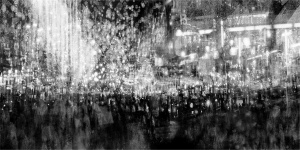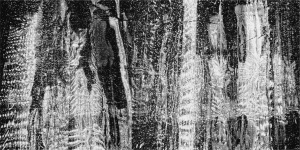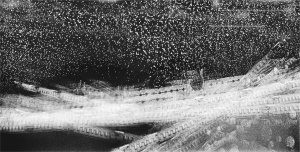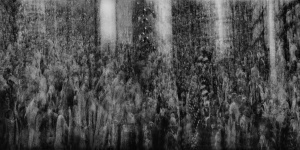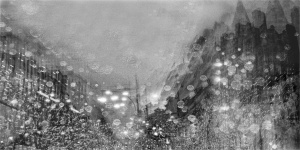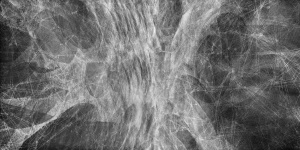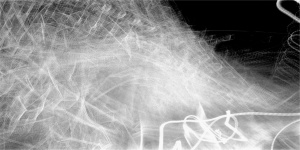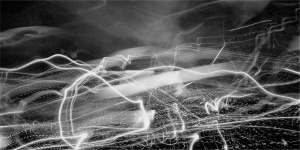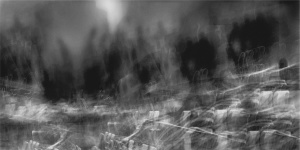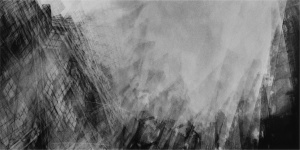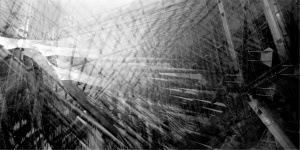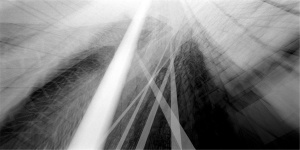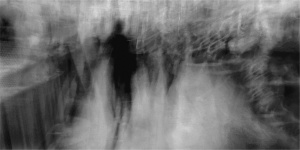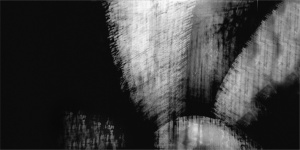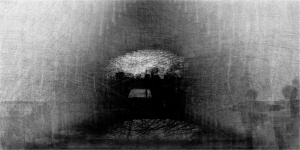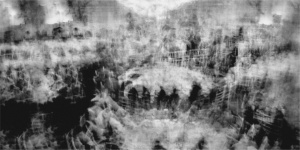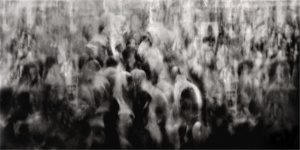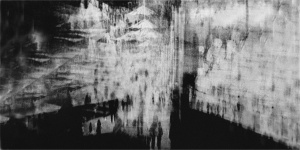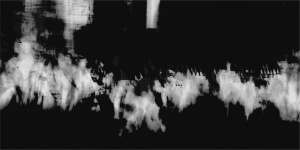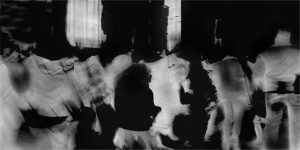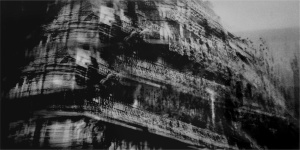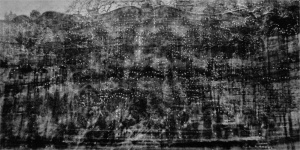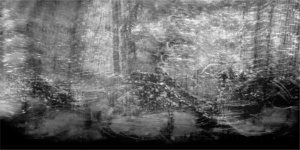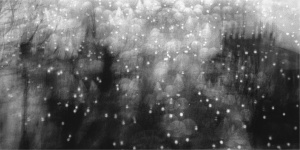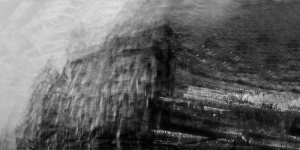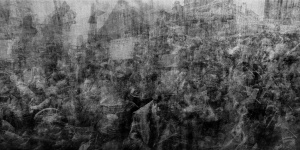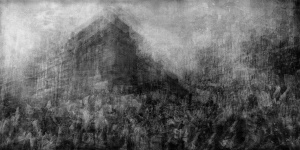Dreaming Of Le Gibet
Curated by SAMIA ASHRAF
‘Dreaming of Le Gibet’ is a magical journey that unravels the mind at sleep. The exhibition features 27 black-and-white photographic pieces, each measuring 65cm x 120cm. These hallucinatory works by James Dean Diamond draw on the music of the French classical composer Joseph-Maurice Ravel (1875–1937) and, in particular, his piano piece ‘Gaspard de la Nuit’ (‘The Keeper of the Night’). Written in 1908, the latter is a complicated orchestration of three movements: ‘Ondine’, ‘Le Gibet’ and ‘Scarbo’.
The inspiration lies with the temporal and formal innovations of ‘Le Gibet’, which reveal a ‘nonlinearity, continuity and discontinuity’1, paralleling the obscure nature of dreams. Similarly, Diamond’s approach to creating atmospheric harmonies, instrumental textures and effects are in line with Ravel’s spatial models of time.
Using the urban environs as the subject to illustrate a state of mind, the artwork oscillates between figuration and abstraction. Rather than employ digital methods, Diamond conceives the work in film, with formal rigour, over a period of five years. Shooting in London and Paris, he begins the process by assessing the surroundings in order to calculate the distribution of light from each surface. The camera is repositioned, slowing with multiple exposures – up to 200 exposures within a single frame – and structures, constructions, surfaces, space and scale are overlaid to make a ‘unified composition’2. Moreover, this method of raster scanning echoes Ravel’s rapid rhythm of a snare drum. Built with layers of gestural abstraction, the pieces extend ‘theological time and cosmic time’3, as well as make reference to a painterly practice. Here, photography functions on both perceptive and observational levels, where the principal concern is to reconfigure the moment, while expanding the possibilities of the medium.
This twilight state is Diamond’s most cinematic, imbued with an ambiguity and within which ethereal figures and unidentifiable buildings merge into an abstracted pictorial language. A bustling metropolis festooned with bright lights and hoardings intermingles with the mass movement of human forms as the celestial vibrations of electromagnetic waves unfurl. An illusion full of mystery has Gothic settings, impressionist undulations of a carousel glimmering with snow, and a contemporary conurbation of sharp graphic angles accelerating through time.
Alluding to Dante’s Inferno and Francisco de Goya’s etchings, the densely black compositions lure the viewer to a stage engulfed by a metaphysical darkness – a revolutionary crowd stirs to assemble at a medieval public gallows. Other pieces are set amid the resemblance of a shock wave from a nuclear blast, where the disintegration of the outer shell of the architectural spaces exposes the skeletal frame. Diamond’s thoughts are clouded by the plight of ‘the world’s 65 million forcibly displaced people (the most ever recorded)’4 and an unease towards the rise of nationalism.
Diamond’s own dreams have triggered his fascination with the field of oneirology, the scientific study of dreams. Brain-mapping research suggests dreams are contributed to the transference of the short-term memory, a day or a week into a long-term retention. From an unconscious state the brain awakens and permits the semiconscious to observe the collation, slicing and sequence of multiple scenes. A bioelectric chemical process transmits at great speed, stimulating visual imagery and virtual encounters which, on occasion, we recollect when conscious. This examination somewhat aids the development of AI, while another theory proposes that DNA is embedded within our ancestors’ memories and dreams. The enactment of dreams also becomes the interplay of memory and experience, where visions surface as an expression of the interiority of the artist. Diamond’s visually complex vistas contemplate the uncertainty that pervades these fragmented images – and present a world where ‘time scintillates, and the dream is knowledge’5.
1 Jessie Fillerup, ‘Eternity in Each Moment: Temporal Strategies in Ravel’s “Le Gibet”, ‘A journal of the society for music theory’ (MTO), Vol 19, No 1, March 2013
2 A conversation between Thomas Ruff, Wenzel S Spingler & Valeria Liebermann: Thomas Ruff Photograms, Gagosian Gallery, Summer 2014
3 Royal Academy of Art, London, Anselm Kiefer discusses his work with Tim Marlow, Gagosian Gallery, September-October 2014
4 Simon Kuper, ‘The power of a Syrian success story’, ‘The Financial Times Weekend Magazine’, 15/16 April 2017
5 Paul Valéry, ‘Le Cimetière marin’ (The Graveyard by the sea), 1922, An Anthology by James R Lawler, edited by Jackson Mathews, Princeton University Press, 1977
The following works are ‘Untitled’ from the series ‘Dreaming of Le Gibet’ | Dimension: 65cm x 120cm | Medium: C -TYPE | Edition: Eight per piece | 2012 - 2017
